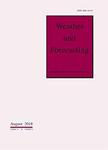版权所有:内蒙古大学图书馆 技术提供:维普资讯• 智图
内蒙古自治区呼和浩特市赛罕区大学西街235号 邮编: 010021

作者机构:Carnegie Mellon Univ Dept Stat & Data Sci Pittsburgh PA 15213 USA Carnegie Mellon Univ Machine Learning Dept Pittsburgh PA USA Mississippi State Univ Dept Geosci Mississippi State MS USA Microsoft AI Dev Accelerat Program Cambridge MA USA
出 版 物:《WEATHER AND FORECASTING》 (Weather Forecast.)
年 卷 期:2023年第38卷第6期
页 面:985-998页
核心收录:
基 金:NSF [DMS-2053804, PHY-2020295] C3.ai Digital Transformation Institute
主 题:Hurricanes typhoons Satellite observations Probability forecasts models distribution Deep learning Artificial intelligence Short-range prediction
摘 要:Because geostationary satellite (Geo) imagery provides a high temporal resolution window into tropical cyclone (TC) behavior, we investigate the viability of its application to short-term probabilistic forecasts of TC convective structure to subsequently predict TC intensity. Here, we present a prototype model that is trained solely on two inputs: Geo infrared imag-ery leading up to the synoptic time of interest and intensity estimates up to 6 h prior to that time. To estimate future TC struc-ture, we compute cloud-top temperature radial profiles from infrared imagery and then simulate the evolution of an ensemble of those profiles over the subsequent 12 h by applying a deep autoregressive generative model (PixelSNAIL). To forecast TC in-tensities at hours 6 and 12, we input operational intensity estimates up to the current time (0 h) and simulated future radial pro-files up to 112 h into a nowcasting convolutional neural network. We limit our inputs to demonstrate the viability of our approach and to enable quantification of value added by the observed and simulated future radial profiles beyond operational intensity estimates alone. Our prototype model achieves a marginally higher error than the National Hurricane Center s official forecasts despite excluding environmental factors, such as vertical wind shear and sea surface temperature. We also demonstrate that it is possible to reasonably predict short-term evolution of TC convective structure via radial profiles from Geo infrared im-agery, resulting in interpretable structural forecasts that may be valuable for TC operational guidance.